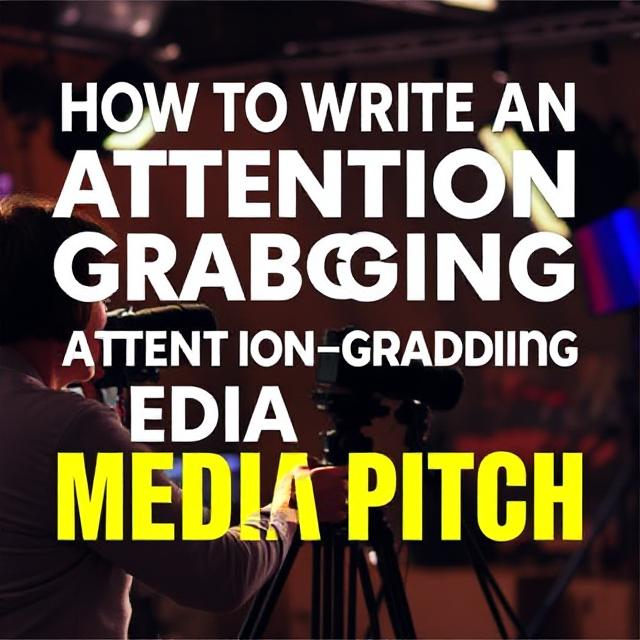
Getting your story noticed requires more than just a well-crafted press release. Journalists and editors receive hundreds of pitches daily, so how do you make yours stand out? The answer lies in writing a compelling and attention-grabbing media pitch. This article will take you through the essentials of creating a media pitch that captures attention and generates results.
What is a Media Pitch?
A media pitch is a brief, personalized message sent to journalists, editors, or influencers to propose a story idea or request media coverage. Unlike a press release, which is a public announcement, a media pitch is targeted and designed to spark interest in a specific publication or media outlet.
Why is a Media Pitch Important?
A well-written media pitch can open doors to powerful media exposure, helping to:
- Build your brand’s credibility
- Increase visibility and reach
- Drive traffic and sales
- Establish thought leadership
Steps to Write an Attention-Grabbing Media Pitch
1. Do Your Research
Before you start writing, take time to research the journalist or publication you’re targeting.
- Know their audience: Ensure your story aligns with their readership or viewership.
- Understand their beat: Journalists specialize in specific topics (tech, lifestyle, business, etc.), so target the right person.
- Read recent articles: Familiarity with their recent work helps tailor your pitch.
2. Craft a Compelling Subject Line
Your subject line is the first thing a journalist sees, and it determines whether your email gets opened.
Tips for writing a great subject line:
- Keep it short and to the point (50 characters or less).
- Make it intriguing but not clickbaity.
- Highlight the value or unique angle of your story.
Example:
“How [Your Company Name] is Revolutionizing Green Tech in 2025”
3. Personalize Your Pitch
Avoid sending generic pitches. A personalized pitch shows that you’ve done your homework.
- Mention the journalist’s name and reference one of their recent articles.
- Explain why your story is relevant to their audience.
- Be conversational and natural in tone.
Example:
“Hi [Journalist’s Name], I loved your recent piece on sustainable fashion trends. I think your readers would be interested in hearing how our brand is taking sustainability to the next level with biodegradable fabrics.”
4. Start Strong with an Engaging Hook
Your opening sentence should immediately capture attention. Avoid long-winded introductions. Get straight to the point with an interesting fact, statistic, or bold statement.
Example:
“Did you know that 90% of packaging waste in the beauty industry ends up in landfills? Our company is tackling this problem with a new zero-waste product line.”
5. Present the Story Angle Clearly
Journalists are looking for newsworthy, relevant, and timely content. Clearly outline the story idea you’re proposing and explain why it matters now.
Answer these questions:
- What is the story?
- Why is it relevant and timely?
- How does it benefit their audience?
6. Keep It Concise
Journalists are busy. Keep your pitch brief—preferably between 150 to 200 words. Avoid unnecessary details and focus on what’s most important. Use bullet points if needed to make your pitch scannable.
7. Include Supporting Information
While keeping your pitch short, it’s crucial to offer additional information or resources. This could include:
- Links to your website, press kit, or relevant articles
- High-quality images or video content
- Data or statistics to back up your story
8. End with a Clear Call-to-Action (CTA)
Close your pitch by encouraging the journalist to take the next step.
- Offer to provide additional information or schedule an interview.
- Be polite and avoid sounding pushy.
Example:
“If you’re interested, I’d be happy to share more details or arrange a call at your convenience.”
9. Proofread and Edit
Spelling and grammar errors can instantly discredit your pitch. Review your email carefully before hitting send. Consider reading it aloud to catch awkward phrasing or mistakes.
Common Mistakes to Avoid
- Generic pitches: Personalization is key. Avoid copy-pasting the same pitch to multiple journalists.
- Overly promotional tone: Journalists aren’t looking for an advertisement; they want a story.
- Too much jargon: Keep it simple and easy to understand.
- Ignoring timing: Ensure your story is timely and relevant.
Example of an Effective Media Pitch
Subject Line:
“How [Startup Name] is Using AI to Solve Urban Food Waste”
Body:
Hi [Journalist’s Name],
I hope you’re well. I recently read your article on innovative food tech solutions and thought you might be interested in our story.
[Startup Name] is a new AI-driven platform tackling urban food waste by connecting surplus food from restaurants to local shelters in real-time. Since our launch, we’ve saved over 50,000 pounds of food and partnered with over 100 local businesses.
We’re gearing up for a major expansion in [City Name] this month and would love to share more details with you.
If this sounds like a fit for your audience, I’d be happy to arrange an interview or provide additional information.
Thank you for your time and consideration.
Best,
[Your Name]
[Your Position]
[Company Name]
[Contact Information]
An attention-grabbing media pitch requires research, personalization, and a focus on value. By following these steps, you can increase your chances of getting noticed and securing valuable media coverage.
Remember, the key is to offer a story that’s not only newsworthy but also relevant to the journalist’s audience. With the right approach, your pitch can open the door to exciting media opportunities.

